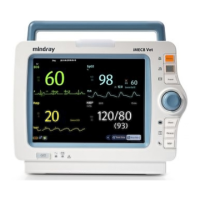6-4
Selecting the [Screens] QuickKey→[Choose Screen]→[View Others Screen]→ , or
Selecting [Main Menu]→[Screen Setup >>]→[Screen Layout >>]→[Choose Screen >>]→[View Others
Screen]→ .
2. Select [Setup] in the [View Other Patient] window.
3. Select the desired monitors from the [Connected Monitor List], and then select the button. The selected
monitors constitute a Care Group.
6.4.2 Viewing the Care Group Overview Bar
The Care Group overview bar is located at the bottom of the [View Other Patient] window. In the overview bar, the
department and bed label for any Care Group beds are displayed. For telemetry, # is displayed before the department
label. The color in which a Care Group bed appears matches its status:
Red: indicates the bed is giving high-level physiological alarms or the telemetry is giving alarm, such as nurse call or
event.
Yellow: indicates the bed is giving medium- or low-level physiological alarms, or medium-level technical alarms.
Blue: indicates the bed is giving low-level technical alarms.
Grey: indicates the bed fails to be networked or is in the standby mode.
You can view a Care Group bed’s alarms by selecting it from the care group, or you can select the [View This Patient]
button to view this bed in the [View Other Patient] window.
For more details about Care Group alarms, refer to the Alarms chapter.
6.4.3 Understanding the [View Other Patient] Window
When you first open the [View Other Patient] window, the monitor automatically selects a monitor from the network to
display in the [View Other Patient] window.
4

